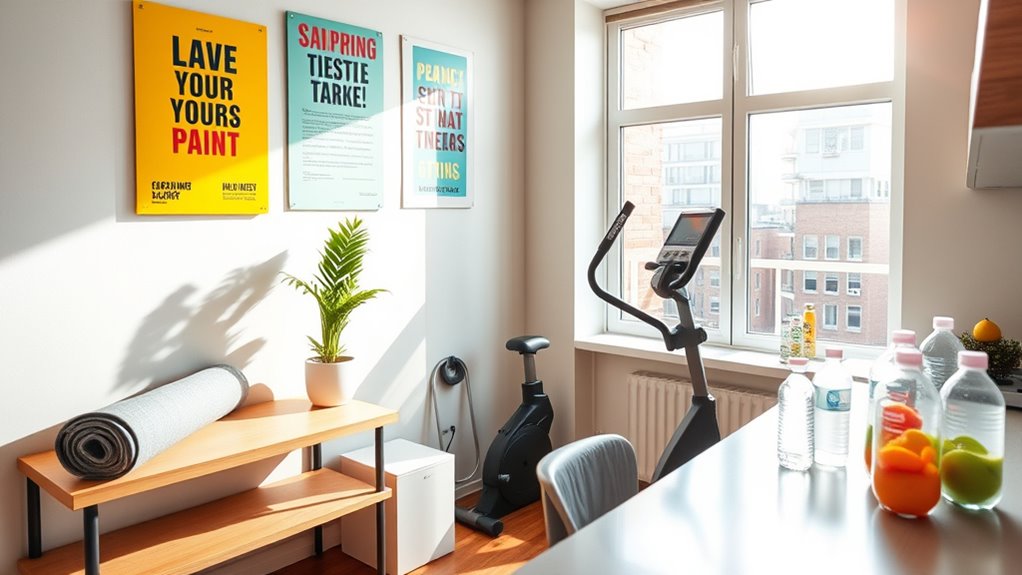To stay healthy in a compact living space, prioritize good air quality by regularly ventilating, using air purifiers, and managing humidity levels. Optimize your layout with multi-purpose furniture and vertical storage to boost space efficiency. Keep your environment clean by frequent cleaning and maintaining proper airflow. Incorporate natural elements like plants for added air purification and mental well-being. Continuous efforts in these areas will help create a healthier, more comfortable home—discover more tips to make it easier.
Key Takeaways
- Regularly ventilate your space and use air purifiers to ensure fresh, pollutant-free indoor air.
- Optimize space with multi-purpose furniture and vertical storage to reduce clutter and improve air circulation.
- Incorporate plants like snake plants or pothos to naturally filter air and promote a healthier environment.
- Maintain cleanliness through frequent vacuuming, surface wiping, and bedding washing to reduce dust and allergens.
- Designate specific zones for sleeping, working, and relaxing to enhance comfort and support mental well-being.

Living in a compact space doesn’t mean you have to compromise your health. In fact, with the right strategies, you can create a healthy, comfortable environment that maximizes every square inch. The key lies in focusing on indoor air quality and effective space optimization. These elements not only enhance your living experience but also support your overall well-being.
First, prioritize indoor air quality. In small spaces, pollutants can accumulate quickly, making it essential to keep the air clean and fresh. Regularly ventilate your home by opening windows whenever possible, even if just for a few minutes each day. This helps circulate fresh air and reduces indoor pollutants such as dust, pet dander, and cooking fumes. Consider investing in air purifiers with HEPA filters, which can trap allergens and airborne particles, improving the air you breathe. Keep humidity levels balanced—too high can promote mold growth, while too low can cause dryness and respiratory irritation. Using a dehumidifier or humidifier as needed ensures ideal humidity levels, contributing to better indoor air quality. Incorporating ventilation strategies can further improve airflow and reduce pollutant buildup.
Next, focus on space optimization to reduce clutter and create a more functional environment. A tidy space not only looks better but also promotes mental clarity and reduces stress. Use multi-purpose furniture, such as beds with storage drawers or fold-away desks, to maximize functionality without sacrificing space. Vertical storage solutions like wall-mounted shelves and hooks free up floor space and keep essentials within reach. Regularly declutter and donate items you no longer need; a clutter-free environment minimizes dust accumulation and makes cleaning easier. Implementing smart layout designs ensures you utilize every corner efficiently, creating distinct zones for sleeping, working, and relaxing without feeling cramped.
Additionally, pay attention to airflow and natural light, as these elements influence indoor air quality and your overall health. Position your furniture to allow for unobstructed airflow and maximize sunlight exposure, which naturally disinfects and freshens the space. Use plants that are known for purifying indoor air, such as snake plants or pothos, to add a touch of nature and further improve air quality.
Finally, maintaining a routine of regular cleaning keeps dust, mold, and allergens at bay, supporting healthier indoor air quality. Vacuum with a HEPA filter, wipe down surfaces frequently, and wash bedding regularly. Small adjustments, like using natural cleaning products, can make a big difference in maintaining a healthy living environment. By combining proactive air quality management with strategic space optimization, you set the stage for a healthier, more comfortable life in your compact home.
Frequently Asked Questions
How Can I Improve Indoor Air Quality in Small Spaces?
To improve indoor air quality in small spaces, place an air purifier near your main living area or source of pollution. Additionally, select indoor plants like snake plants or pothos, which naturally filter toxins. Keep windows open when possible to increase ventilation, and avoid smoking indoors. Regularly clean your space to reduce dust and allergens, creating a healthier environment. These steps help guarantee better air quality in tight quarters.
What Are Quick Stress Relief Methods for Tiny Living Areas?
When feeling overwhelmed in your tiny space, try quick stress relief methods like deep breathing exercises and progressive muscle relaxation. Practice stress management by taking short breaks to stretch or meditate. Use calming scents like lavender or chamomile to promote relaxation. These relaxation techniques help you reset mentally and physically, making it easier to manage daily pressures. Incorporate these simple strategies into your routine for instant relief and improved well-being.
How Do I Prevent Mold in Compact Bathrooms?
Think of your bathroom like Pandora’s box—sealing it tight keeps trouble out. To prevent mold, use mold-resistant materials like tiles and paint, and guarantee good bathroom ventilation by installing an exhaust fan or opening a window after showers. Wipe down surfaces regularly and fix leaks promptly. These simple steps help keep moisture at bay, protecting your space and health, even in a tiny bathroom.
What Are Space-Saving Exercise Equipment Options?
You can maximize your space with folding exercise equipment like collapsible yoga mats, foldable benches, and compact gym gear. These options are perfect for small spaces, allowing you to store them easily when not in use. Look for multi-functional, space-saving exercise equipment that can be tucked away, so you can maintain your fitness routine without clutter. This way, you stay healthy and fit without sacrificing precious space.
How Can I Store Healthy Food Efficiently in Small Kitchens?
Your small kitchen might feel like a tiny universe, but you can still store healthy food efficiently. Use smart shelving to maximize vertical space and keep meal prep essentials organized. Opt for stackable containers and clear jars to easily identify ingredients. Rotate items regularly to prevent waste, and designate specific spots for fresh produce. With these tips, you’ll turn your limited space into a well-organized hub for healthy living.
Conclusion
Living in a small space is like tending a delicate garden—you must nurture it carefully to thrive. By staying active, eating smart, and creating a clean environment, you keep your health rooted and resilient. Remember, even in a compact area, your well-being blossoms with attention and effort. Think of your space as a mirror of yourself; tend to it, and it’ll reflect a healthier, happier you. Your well-being is the seed, and your habits are the water that makes it grow.







